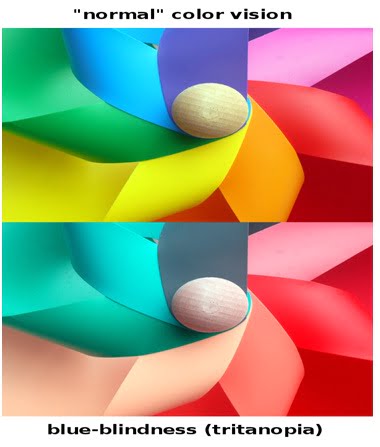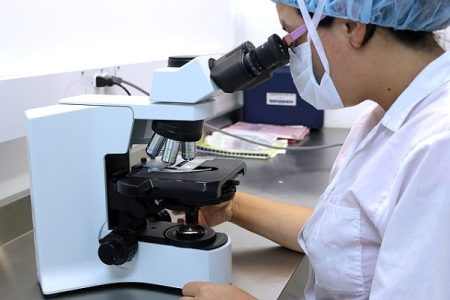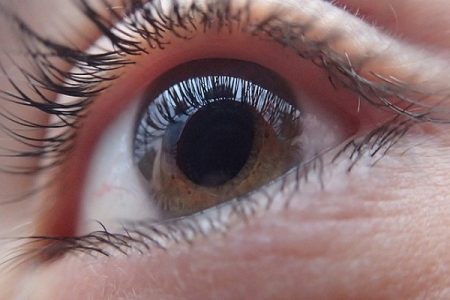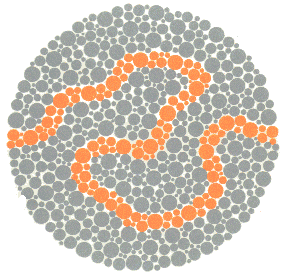Blue-Yellow Color Blindness or Blue-Green Color Blindness
- Updated on: Jul 23, 2024
- 3 min Read
- Published on Dec 17, 2018

Knowing about Colorblindness
Abnormal photo-pigments are known to cause genetic or inherited color blindness. These photo-pigments are color-detecting molecules which are located in cone-shaped cells within the retina and are known as cone cells. In humans, some genes are responsible for the production of these photo-pigments. Any defect in these genes can lead to color blindness. Out of all types of colorblindness, blue-yellow color blind is relatively uncommon. The condition misleads a person’s vision of different shades of blue with green, and some shades of yellow with violet.
The phrases ‘blue yellow color blindness’ or ‘blue yellow color blind’ often confuses people and therefore, the terms ‘blue green color blindness’ or ‘blue green color blind’ appear to be more accurate depending upon the vision. Blue-cone (tritan) photo-pigments defects affect the short-wavelength cone (S-cone).
There are various types of blue yellow color blindness (color vision deficiency) as discussed herein. Find out colour vision deficiency and colour blindness, including how to get tested for blue yellow color blindness, and why it happens, here.
More: Retinal cells grown in labs provide clue to color blindness.
More: Color Blindness: Causes, Symptoms, Diagnosis, and Treatment
Types of Blue Yellow Color Blindness
Listed below are types of blue yellow color blindness.
Tritanopia
During tritanopia, the S-cones (short) are missing or they become non-functional whereas only long and medium-wavelength cones are present. This results in blindness to the blue end of the spectrum.
Tritanomaly
During tritanomaly, the S-cones are defective or have some kind of mutation, and operate below the normal capacity to interfere with a person’s ability to see some shades of blue. Tritanomaly is an alleviated or more severe form of blue-yellow color blindness.
How do colors appear to a blue yellow color blind person?

Image credit: Wikimedia
What leads to the development of blue yellow color blindness?
In men, blue yellow color blindness is not prominent because the gene that causes the S-cones to be absent or defective is not found on the X chromosome, but rather chromosome 7. This leads to a conclusion that tritanopia and tritanomaly are not sex-linked traits, which allow us to estimate that women and men have equal chances of acquiring blue-yellow color blindness.
Causes: Factors which enhance non-inherited color blindness
Colorblindness is often an inherited condition but if we specifically talk about blue yellow colorblindness, there are more number of cases that are affected by non genetic mechanisms.
Some factors which are known to enhance non-congenital color blindness are:
- It is often observed that people who consume large quantities of alcohol have color discrimination problem. High incidence rate of tritanopia was estimated in these people.
- Also, any injury in the front or back of the head might also be a reason for the development of blue-yellow color blindness.
- In some cases, macular degeneration, which is a result of the normal aging process, leads to impaired vision by damaging the retina resulting in colorblindness.
- In rare cases, diabetes might also be a reason for a damaged retina which causes tritanopia or tritanomaly.
The estimated number of tritanopes/tritanomalous patients is very small of about 1 in 30-50,000 in all people.
Diagnosing blue yellow color blindness (Blue yellow color blind test)
Blue yellow or blue green colorblindness is characterized by a loss of color discrimination capability for shades of blue and yellow which might be associated with age-related factors, genetic or inherited factors, exposure to certain toxins such as mercury, etc. For appropriate diagnosis of blue-yellow color blindness, doctors recommend the Ishihara Color Test as a primary method. This is an established blue yellow color blind test and for other types of color blindness too.
We know that there is no cure for any type of color blindness. EnChroma glasses are recommended to the patients. They are not effective in treating tritanomaly or tritanopia (blue-yellow color blindness) but in some cases, these lenses or contacts with filters can be used to temporarily reduce the impact of the problem and enhance colored vision.
There are several ongoing clinical trials being conducted to study how cones develop in the retina and also to detect factors which improve or restore visual function of the cone cells. Scientists are hoping and are working to find a cure to colorblindness. We may have some potential treatments for color blindness in future. But as of now, the condition is not curable.












